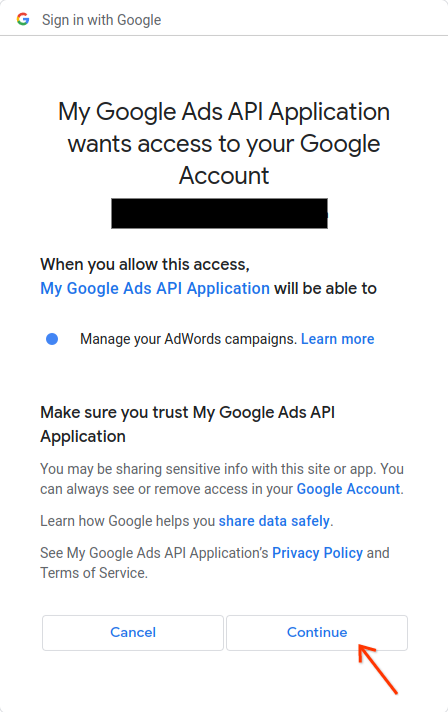يرشدك هذا الدليل إلى كيفية إعداد OAuth 2.0 للوصول إلى واجهة برمجة التطبيقات باستخدام بيانات الاعتماد الخاصة بك ومسار أجهزة الكمبيوتر المكتبي أو مسار الويب. يجب تنفيذ هذه الخطوات مرة واحدة فقط، ما لم تلغي أو تحذف أو تحتاج إلى تغيير النطاقات المسموح بها لبيانات اعتماد OAuth 2.0.
إنشاء بيانات اعتماد OAuth 2.0
اتّبِع الخطوات لضبط مشروع على Google API Console لواجهة برمجة التطبيقات Google Ads API.
نزِّل ملف JSON الخاص بالعميل من خلال النقر أولاً على رمز تنزيل ملف OAuth العميل ثم على الزر تنزيل ملف JSON في الشاشة التالية.
احفظ الملف في الدليل الرئيسي لديك حتى يكون لديك الآن الملف المحلي
~/client_secret_XXX.apps.googleusercontent.com.json(حيث سيكون XXX هو قيم خاصة بمشروعك). سنستخدم هذا الملف في الخطوة التالية لمحاولة تنفيذ مثال الرمز البرمجي.
إعداد مكتبة العميل
-
في وحدة طرفية، شغِّل مثال الرمز البرمجي
generate_user_credentials. استخدِم علامات سطر الأوامر لتمريرملف JSON الذي نزّلته في الخطوة السابقة.generate_user_credentials.py \ --client_secrets_path=${HOME}/client_secret_XXX.apps.googleusercontent.com.json -
يطلب منك مثال الرمز هذا الانتقال إلى عنوان URL حيث عليك تفويض التطبيق للوصول إلى حسابك على "إعلانات Google" نيابةً عنك.
Paste this URL in your browser: https://accounts.google.com/o/oauth2/auth?access_type=offline&client_id=****...
انتقِل إلى عنوان URL في جلسة تصفّح خاصة أو نافذة تصفّح متخفٍّ. سجِّل الدخول باستخدام حساب Google الذي تستخدمه للوصول إلى "إعلانات Google". وعادةً ما تكون هذه الرسالة الإلكترونية هي معلومات تسجيل الدخول إلى حساب إداري على "إعلانات Google" يحتوي على جميع الحسابات التي تحتاج إلى إدارتها ضمن التدرّج الهرمي لحساباته. انقر على متابعة في شاشة طلب الموافقة على بروتوكول OAuth 2.0.

سيتم نقلك إلى صفحة تتضمّن رسالة تشير إلى نجاح عملية التفويض.
Your refresh token has been fetched. Check the console output for further instructions.
-
ارجع إلى وحدة التحكّم التي نفّذت فيها مثال الرمز.ستلاحظ أنّه قد اكتمل مثال الرمز ويعرض رمز إعادة التنشيط وبعض التعليمات، متبوعًا بتعليمات يجب اتّباعها لضبط مكتبة العميل:
Your refresh token is: 1/Yw......................................... Add your refresh token to your client library configuration as described here: https://developers.google.com/google-ads/api/docs/client-libs/python/configuration

